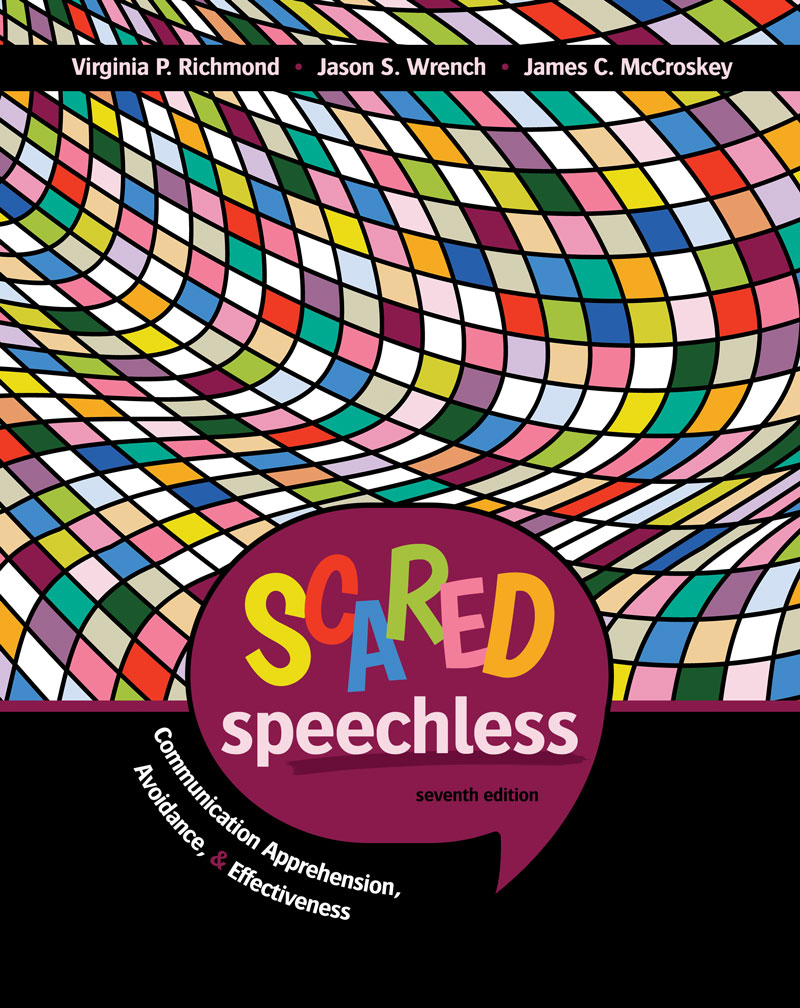Scared Speechless: Communication Apprehension, Avoidence & Effectiveness
Author(s): Virginia P Richmond , Jason S Wrench , James C McCroskey
Edition: 7
Copyright: 2018
Edition: 7
Copyright: 2018
Choose Your Format
Scared Speechless: Communication Apprehension, Avoidance, and Effectiveness by Virginia P. Richmond, Jason S. Wrench, and James C. McCroskey examines the most widespread communication problem in our society, shyness, defining the issue and exploring why it occurs.
Intended for those people who are “scared speechless” in some or most environments, the new seventh edition provides various methods that have been developed to help people overcome apprehension and anxiety about communicating.
Written by many of the leading researchers in the area, Scared Speechless: Communication Apprehension, Avoidance, and Effectiveness:
- Introduces readers to the process of human communication.
- Discusses communication apprehension, willingness to communicate, and the primary types of shyness.
- Examines the impact that one’s culture can have on communication apprehension and how communication apprehension affects intercultural communication.
- Summarizes some of the major effects of communication apprehension, willingness to communicate, and shyness in people’s everyday lives and considers the problems of compulsive communicators.
- Includes access to innovative voice analytics technology that demonstrates exactly how one can improve their oral delivery and make the best impression – every time!
Preface
1. An Overview of Human Communication
Definition of Human Communication
Components of the Human Communication Process
Noise
Functions of the Communication Process
Misconceptions About Communication
Misconception 1: Meanings are in the Words Themselves
Misconception 2: Interpersonal Communication is the Same as Intimate Communication
Misconception 3: Communication is Solely a Verbal Process
Misconception 4: Telling is Communicating
Misconception 5: Communication Will Solve All Our Problems
Misconception 6: Communication is Always a Good Thing
Misconception 7: The More Communication, the Better
Misconception 8: Communication Can Break Down
Misconception 9: Communication is a Natural Human Ability|
Misconception 10: Communication Competence Equals Communication Effectiveness
2. Shyness: The Behavior of Not Communicating
Individual Differences in Communication
Effects of Individual Differences
The Nature of Shyness
The Causes of Shyness
Types of Shy People
Measures of Shyness
3. Scared Speechless: The Fear of Communication
The Nature of Communication Apprehension
Types of Communication Apprehension
Causes of Communication Apprehension
Effects of Communication Apprehension
Personality Correlates of Apprehension
Compulsive Communicators
4. Intercultural and Interethnic Communication Apprehension
The Influence of Culture on Communication Apprehension
Communication Apprehension with Other Cultures
Intercultural Communication Apprehension
Interethnic Communication Apprehension
Communication Apprehension in Other Cultural Contexts
5. Impact of Apprehension, Shyness, and Low Willingness to Communicate in Life
Behaviors of Quiet and Talkative People
Quiet vs. Talkative People: A Generalized Profile
Interpersonal Perceptions
Everyday Life
• Peer Relationships
• Family Relationships
• School Environment
• Work Environment
• Health Care
• Online
6. Communication Avoidance and Communication Effectiveness
Contributors to Communication Effectiveness
Self-Perceived Communication Competence
Sociocommunicative Style
Immediacy
7. Reducing Apprehension and Anxiety About Communication
Theories of Causes
Treatment Approaches
Samples of Nonthreatening to Threatening Communication Situations
Summary
Glossary
References
Appendices
A Introversion Scale
B Shyness Scale (SS)
C Willingness to Communicate Scale (WTC)
D Writing Apprehension Test (WAT)
E Singing Anxiety Test (SAT)
F Personal Report of Communication Apprehension (PRCA-24)
G Personal Report of Public Speaking Anxiety (PRPSA)
H Communication Apprehension in Generalized Contexts
I Situational Communication Apprehension Measure (SCAM)
J Self-Perceived Communication Competence Scale (SPCC)
K Talkaholism or Compulsive Communication
L Personal Report of Intercultural Communication Apprehension (PRICA)
M Personal Report of Interethnic Communication Apprehension (PRECA)
N Religious Communication Apprehension (RCA)
O Sociocommunicative Orientation
P Fear of Physician (FOP)
Q Computer-Mediated Communication Apprehension (CMCA)
Scared Speechless: Communication Apprehension, Avoidance, and Effectiveness by Virginia P. Richmond, Jason S. Wrench, and James C. McCroskey examines the most widespread communication problem in our society, shyness, defining the issue and exploring why it occurs.
Intended for those people who are “scared speechless” in some or most environments, the new seventh edition provides various methods that have been developed to help people overcome apprehension and anxiety about communicating.
Written by many of the leading researchers in the area, Scared Speechless: Communication Apprehension, Avoidance, and Effectiveness:
- Introduces readers to the process of human communication.
- Discusses communication apprehension, willingness to communicate, and the primary types of shyness.
- Examines the impact that one’s culture can have on communication apprehension and how communication apprehension affects intercultural communication.
- Summarizes some of the major effects of communication apprehension, willingness to communicate, and shyness in people’s everyday lives and considers the problems of compulsive communicators.
- Includes access to innovative voice analytics technology that demonstrates exactly how one can improve their oral delivery and make the best impression – every time!
Preface
1. An Overview of Human Communication
Definition of Human Communication
Components of the Human Communication Process
Noise
Functions of the Communication Process
Misconceptions About Communication
Misconception 1: Meanings are in the Words Themselves
Misconception 2: Interpersonal Communication is the Same as Intimate Communication
Misconception 3: Communication is Solely a Verbal Process
Misconception 4: Telling is Communicating
Misconception 5: Communication Will Solve All Our Problems
Misconception 6: Communication is Always a Good Thing
Misconception 7: The More Communication, the Better
Misconception 8: Communication Can Break Down
Misconception 9: Communication is a Natural Human Ability|
Misconception 10: Communication Competence Equals Communication Effectiveness
2. Shyness: The Behavior of Not Communicating
Individual Differences in Communication
Effects of Individual Differences
The Nature of Shyness
The Causes of Shyness
Types of Shy People
Measures of Shyness
3. Scared Speechless: The Fear of Communication
The Nature of Communication Apprehension
Types of Communication Apprehension
Causes of Communication Apprehension
Effects of Communication Apprehension
Personality Correlates of Apprehension
Compulsive Communicators
4. Intercultural and Interethnic Communication Apprehension
The Influence of Culture on Communication Apprehension
Communication Apprehension with Other Cultures
Intercultural Communication Apprehension
Interethnic Communication Apprehension
Communication Apprehension in Other Cultural Contexts
5. Impact of Apprehension, Shyness, and Low Willingness to Communicate in Life
Behaviors of Quiet and Talkative People
Quiet vs. Talkative People: A Generalized Profile
Interpersonal Perceptions
Everyday Life
• Peer Relationships
• Family Relationships
• School Environment
• Work Environment
• Health Care
• Online
6. Communication Avoidance and Communication Effectiveness
Contributors to Communication Effectiveness
Self-Perceived Communication Competence
Sociocommunicative Style
Immediacy
7. Reducing Apprehension and Anxiety About Communication
Theories of Causes
Treatment Approaches
Samples of Nonthreatening to Threatening Communication Situations
Summary
Glossary
References
Appendices
A Introversion Scale
B Shyness Scale (SS)
C Willingness to Communicate Scale (WTC)
D Writing Apprehension Test (WAT)
E Singing Anxiety Test (SAT)
F Personal Report of Communication Apprehension (PRCA-24)
G Personal Report of Public Speaking Anxiety (PRPSA)
H Communication Apprehension in Generalized Contexts
I Situational Communication Apprehension Measure (SCAM)
J Self-Perceived Communication Competence Scale (SPCC)
K Talkaholism or Compulsive Communication
L Personal Report of Intercultural Communication Apprehension (PRICA)
M Personal Report of Interethnic Communication Apprehension (PRECA)
N Religious Communication Apprehension (RCA)
O Sociocommunicative Orientation
P Fear of Physician (FOP)
Q Computer-Mediated Communication Apprehension (CMCA)


